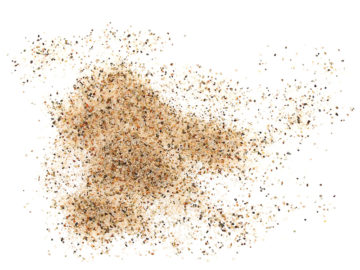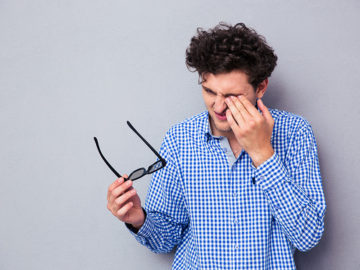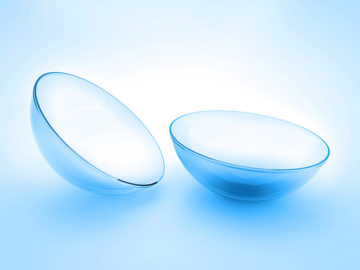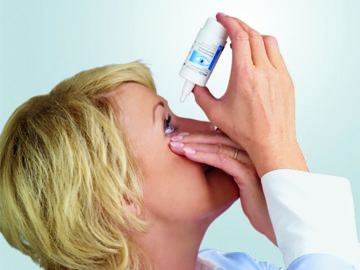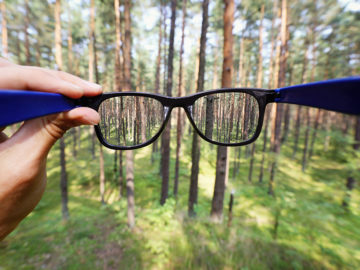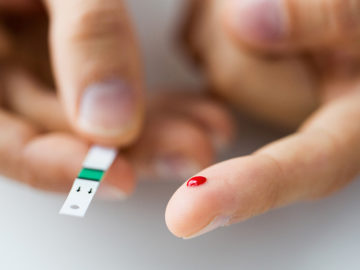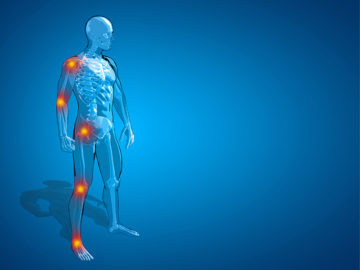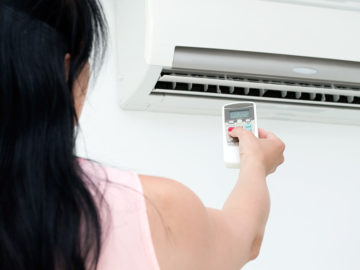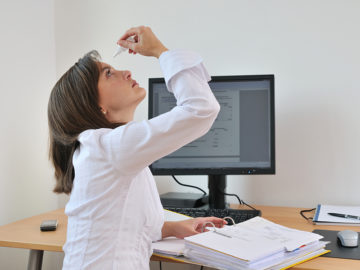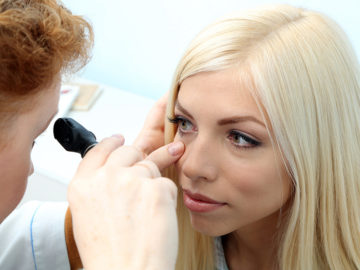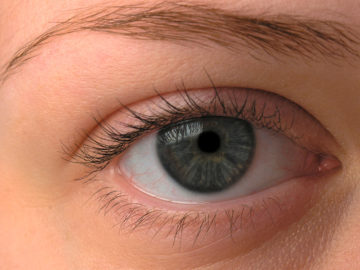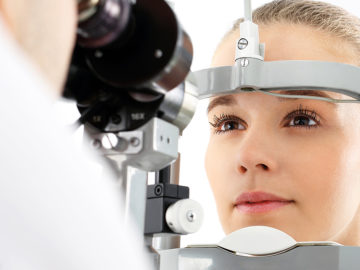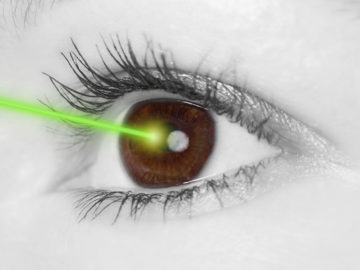Eyelid margin inflammation (Blepharitis): causes, symptoms and treatment
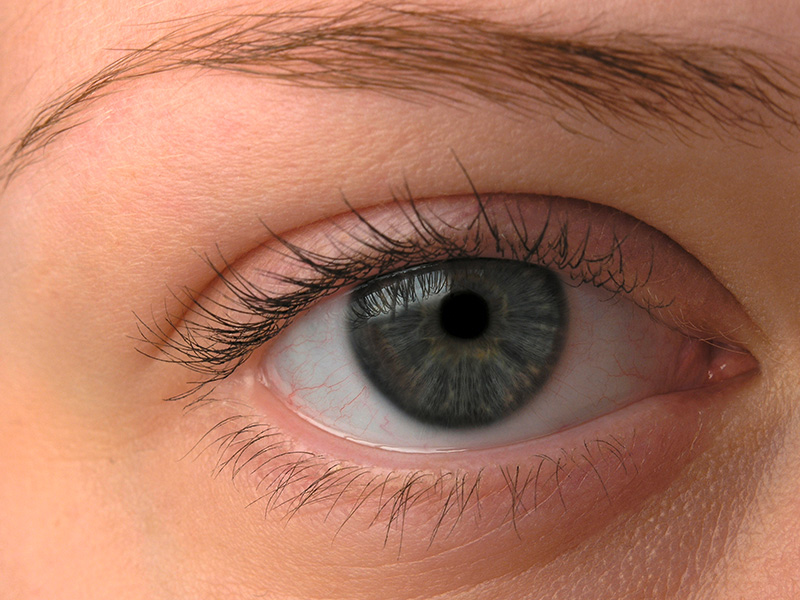
Wer vermutet, an einer Lidrandentzündung zu leiden, sollte einen Augenarzt aufsuchen.
If the eyelids are reddened, crusty and burn, this is usually caused by eyelid margin inflammation. The cause for this inflammation is blockage of the meibomian glands on the inside of the eyelids, for example due to an infection or an over-productsion of oil.
Doctors usually use antibiotic creams for treatment. In addition, patients also have to ensure strict eye hygiene. The disease can either be acute or chronic.
What are the causes of, and risk factors for, eyelid margin inflammation?
Special glands are located on the inside of the eyelids which secrete oil at regular intervals. With every blink, oil is spread evenly over the eye through the lacrimal fluid, so that the eyelids can slide unhindered over the eye and tears cannot easily evaporate.
If the glands become blocked, maybe due to infection, the eyelids become inflamed. In addition, those affected often suffer from dry eyes. The reason: the meibomian glands produce an oil secretion which is an important component of the lacrimal fluid. If the gland openings become blocked, the tear film becomes unstable and the eye dries out.
Types of eyelid margin inflammation
- Infectious eyelid margin inflammation: infectious blepharitis is normally triggered by staphylococci. Staphylococci are bacteria which are present on everybody’s skin (also on the eyelid). If these bacteria gain enter the meibomian gland, it can happen that the sebum becomes more viscous. This causes the glands to block more and more such that the sebum can no longer be secreted. As well as bacterial infection, there is also the possibility of viral infection, for example with the herpes virus.
- Non-infectious eyelid margin inflammation: in some people, the glands produce too much oil (seborrhoea). The excess secretion sticks the eyelashes together which in turn blocks the glands. Non-infectious risk factors also include external influences, such as dust, draughts or smoke, all of which can encourage the development of blepharitis.
- Quite often, there is not just one reason for eyelid margin inflammation but rather several factors. Doctors talk about “triple-S syndrome” when seborrhoea, a staphylococci infection and dry eyes (sicca syndrome) occur together.
What are the symptoms of eyelid margin inflammation?
Typical symptoms of eyelid margin inflammation are similar to those of dry eyes. These include:
- burning
- itching
- reddened eyes
- reddened lid margins
- shiny lid margins
- foreign body sensation
- build-up of flaky skin on the eyelashes
- swollen eyelids
- the eyelashes fall out in the inflamed area
- the eyelashes are very sticky, especially in the morning
Eyelid margin inflammation: how is it diagnosed?
anyone who suspects that they have eyelid margin inflammation should consult an eye doctor about the symptoms they are experiencing. The doctor will make a diagnosis based on the symptoms and the external features of the eyelid margin.
Confirmation comes from an examination of the inside of the eyelid, the cornea or also a swab test on the eyelid margin, which can then later be examined in the laboratory with regard to a bacterial infestation.
How can eyelid margin inflammation be treated?
Treatment of blepharitis depends on the cause of the disease. In addition, the person affected is asked to assist the treatment with appropriate hygiene measures.
Infectious eyelid margin inflammation, caused by bacteria, is usually treated with antibiotic eye ointments. Only in a few cases are antibiotics in tablet form required. If the tear film of the eye is also impaired, the doctor will recommend artificial tears in the form of eye drops as supplementary treatment. HYLODUAL® lubricating eye drops are ideal for dry eyes which accompany inflammatory symptoms because they provide moisture and protection, and thus support healing.
This is what you can do yourself!
Eyelid margin hygiene supports the healing process and is an indispensable activity which you should carry out on a daily basis. There are three steps involved in eyelid margin hygiene:
- Warm-wet compresses: For this, use a clean cloth or a clean face cloth with water which is as warm as you can stand. Place the compresses on the eyes for five to ten minutes. That way viscous secretion, which is blocking the glands, becomes liquefied. Important: put the used cloth or face cloth in the washing basket immediately after treatment. The compress should on no account be used twice.
- Eyelid margin massage: the eyelid margin should be massaged after the compress in order to remove the liquefied sebum from the glands. Use your freshly-washed finger or a cotton bud to do so, always wiping in the direction of the eyelashes. For the upper lid, this means from top to bottom towards the lash line and for the lower lid, from bottom to top in the direction of the lashes.
- Cleaning eyelid margins: the final step in eyelid margin hygiene is eyelid margin cleaning. For this, you need a special cleaning solution from the pharmacist as well as cotton buds or cotton pads. Make sure that the cotton is as lint-free as possible. Never use the implements twice and do not use the same implements for both eyes. That way, you will avoid spreading the bacteria. Dip the cotton in the solution and free your outer eye from incrustations and excess grease.
How does blepharitis progress?
Eyelid margin inflammation can be both acute (quick and intensive) as well as chronic (slow to develop, lasting). The latter is often observed in people with excessive secretion productsion.
With the right treatment, the acute inflammation heals within a few weeks; the chronic form usually cannot be cured, only alleviated. In this case, consistent and daily eyelid margin hygiene is important so that the disease appears less frequently.


